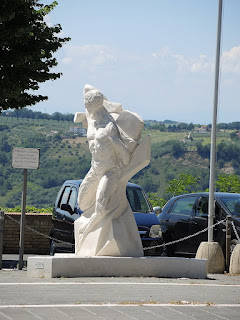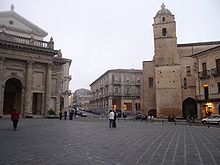Resistance heroine honoured with medal for valour
 |
| Irma Marchiani was deputy commander of her battalion |
Along with three other partisans, Marchiani was shot dead by a firing squad, having a few days earlier been captured by a German patrol as they tried to cross enemy lines. She was 33 years old.
Posthumously awarded a Gold Medal for Military Valour by the postwar Italian government, wrote a poignant letter to his sister, Palmyra, shortly before she was killed, in which she said she would die ‘sure that I have done everything possible for freedom to triumph’.
Marchiani was born in Florence, on February 6, 1911. Her father Adamberto was a railway worker with strong anti-Fascist views who would regularly participate in industrial action aimed at achieving better living conditions for his fellow workers.
After taking part in a large-scale insurrection in June 1914, marked by multiple riots and strikes, Adamberto was given a transfer from Florence to La Spezia in Liguria, seemingly as punishment for his role in the unrest.
During Irma Marchiani’s school years, violent acts committed by supporters of Benito Mussolini’s Italian Fascist Party became commonplace, with squads of Blackshirt thugs allowed to pursue their agenda with little regard for the rule of law. They set fire to premises used by groups associated with their Socialist enemies and handed savage beatings to their opponents.
 |
| Marchiani was familiar with the rugged territory around Sestola in the Modena Apennines |
At school, Irma had excelled at drawing but her father’s sudden unemployment meant she had to give up her education and find a job. She first found work as a milliner, then as an embroiderer and window dresser. She had ambitions to design clothes of her own and in the 1930s enrolled at the Academy of Fine Arts in Carrara so that she could attend a course in anatomical drawing.
Throughout this time, she suffered regularly from bronchial disorders and every year would spend holidays in the Modena Apennines, breathing the clean air and attending a clinic in the village of Sestola.
She happened to be there in September, 1943, when Italy’s surrender to the Allies prompted Nazi Germany to invade the country from the north. Having acquired a knowledge of the territory through her frequent visits, Irma recalled her grandfather’s support for Garibaldi and decided she too would fight for Italy’s freedom. Opting to stay in the mountains rather than return to La Spezia, she joined up with the fledgling resistance movement.
After some months working as a courier, conveying vital messages as the various resistance groups tried to co-ordinate their activities, she joined the Garibaldi Roveda brigade and was assigned to the Matteotti battalion. She was known by the nom de guerre "Anty".
In August, 1944, while fighting near Montefiorino, she was arrested, captured while bravely attempting to help a seriously wounded fellow partisan get to a field hospital. She was imprisoned with a view to being deported to Germany.
 |
| Irma Marchiani was inspired by her grandfather to fight for freedom |
Many of the leaders of the resistance movement were communists but for all their supposedly progressive political ideals, the hierarchy was almost exclusively male and it was rare for a female to have a prominent position. Yet Irma’s bravery and knowledge impressed her colleagues and she was soon promoted, first to commissioner and then deputy battalion commander.
It was her bravery that proved to be her downfall. During fighting in Benedello, she remained alone in occupied territory, again seeking to guide wounded partisans to safety. On the morning of 12 November, while trying to cross enemy lines, she was spotted and was captured by a German patrol along with three fellow fighters.
They were taken to the prison of Pavullo nel Frignano and subjected to questioning under torture. After 15 days of detention, as night fell on November 26, the four were taken outside the prison and executed.
Alongside Marchiani, 27-year-old Domenico "Pisolo" Guidani, 28-year-old Renzo “Remo” Costi and 17-year-old Gaetano “Balilla” Ruggeri were also shot. Today, there is a monument bearing their names set into a wall that marks the spot where they fell.
Another monument commemorating the trio stands at the entrance to the Ducal Park of Pavullo nel Frignano.
Irma’s letter to her sister came to light in May My Blood Serve, a book written about the men and women of the Italian Resistance by the journalist Aldo Cazzullo, published in 2015. It read:
“My beloved Pally, These are the last moments of my life. Beloved Pally I tell you: greet and kiss everyone who will remember me. Believe me, I have never done anything that could offend our name. I felt the call of the homeland for which I fought: now I am here, soon I will no longer be here, I die sure that I have done everything possible for freedom to triumph. Kisses and kisses from your Paggetto. I would like to be buried in Sestola.”
Eight years after her death, Irma’s Gold Medal for Military Valour was pinned to the chest of her brother, Pietro Marchiani, at a ceremony in La Spezia in June, 1952.
The municipalities of Pavullo nel Frignano, Rome, Modena, Savignano sul Panaro, Livorno and Ciampino all have named a street after her.
In Pavullo nel Frignano, the monument outside the Ducal Park is marked with a plaque that bears the words:
“Valiant partisan ..... she participated with indomitable courage in the battles of Montefiorino and Benedello did her utmost in loving assistance to the wounded ..... Arrested and sentenced to deportation, she managed to escape, falling back into the hands of the enemy, fearlessly facing death.”
 |
| The pretty fishing village of Portovenere is just a short distance from La Spezia |
The port town of La Spezia, where Irma Marchiani grew up, is home to Italy's largest naval base. It is often overlooked as a travel destination because of the proximity of the tourist hot spots of the Cinque Terre coastline but offers an affordable alternative base for touring the area as well as an attractive destination in its own right. It is one of Italy’s busiest ports, yet the narrow streets of the old city are deeply atmospheric and have plenty to interest visitors, with a wealth of good restaurants showing off the best Ligurian cuisine. La Spezia is a point of departure for visiting Lerici, Portovenere and the Cinque Terre by boat. The recently-restored Castle of San Giorgio, the 13th century Church of Our Lady of the Assumption and a number of Art Nouveau villas are all worth visiting. The Gulf of La Spezia is known as the Gulf of the Poets because of its associations with the English romantic poets Lord Byron and Percy Bysshe Shelley.
 |
| The Castle of Montecuccolo has stood guard over Pavullo nel Frignano since the 1600s |
In the heart of Frignano Regional Park, the town of Pavullo nel Frignano was once the main Roman stronghold in the Modena Apennines, while it is also home to the medieval Castle of Montecuccolo, birthplace of the 17th century condottiero Raimondo Montecuccoli, which stands well preserved despite the area suffering extensive damage during World War II due to its proximity to the German defensive positions of the Gothic Line. As well as the mediaeval centre, it is well worth visiting the Ducal Palace and Park, the Parish Church of St Bartholomew, the Church of St Francis of Assisi and the modern art gallery. The surrounding countryside offers the Sassoguidano nature reserve, mountain-bike trails, opportunities for trekking, and an equestrian centre.
Also on this day:
1908: The birth of hotelier and businessman Charles Forte
1918: The birth of entrepreneur Giorgio Cini
1940: The birth of mathematician Enrico Bombieri
1949: The birth of politician and businesswoman Letizia Moratti
1963: The death of soprano Amelita Galli-Curci


.PNG)

































